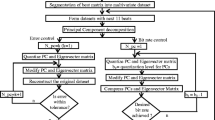Abstract
ECG (Electrocardiogram) is a test that analyzes the electrical behaviour of the heart. ECG is used in diagnosing most of the cardiac diseases. Large amount of ECG data from multiple leads needs to be stored and transmitted, which requires compression for effective data storage and retrieval. Proposed work has been developed with Singular Value Decomposition (SVD) followed by Run Length Encoding (RLE) combined with Huffman Encoding (HE) and Arithmetic Encoding (AE) individually. The ECG signal is first preprocessed. SVD is used to factorize the signal into three smaller set of values, which preserve the significant features of the ECG. Finally, Run Length Encoding combined with Huffman encoding (RLE-HE) and Arithmetic encoding (RLE-AE) individually are employed and the compression performance metrics are compared. The proposed method is evaluated with PTB Diagnostic database. Performance measures such as Compression Ratio (CR), Percentage Root mean square Difference (PRD) and Signal to Noise Ratio (SNR) of the reconstructed signal are used to evaluate the proposed technique. It is evident that the proposed method performs well than the techniques based on SVD and Huffman Encoding. The results show that this method can be efficiently used for compression of ECG signal from multiple leads.








Similar content being viewed by others
References
Kumari, V. S. R., & Abburi, S. (2013). Analysis of ECG data compression techniques. International Journal of Engineering Trends and Technology, 5(3), 116–124.
Priyanka, I. S. (2013). Analysis ECG data compression techniques-a survey approach. International Journal of Emerging Technology and Advanced Engineering, 3(2), 544–548.
Sharma, L. N., Dandapat, S., & Mahanta, A. (2012). Multichannel ECG data compression based on multiscale principal component analysis. IEEE Transactions on Information Technology in Biomedicine, 16(4), 730–736.
Kumar, R., Kumar, A., & Pandey, R. K. (2013). Beta wavelet based ECG signal compression using lossless encoding with modified thresholding. Computers & Electrical Engineering, 39, 130–140.
Padhy, S., Sharma, L. N., & Dandapat, S. (2016). Multilead ECG data compression using SVD in multi resolution domain. Biomedical Signal Processing and Control, 23, 10–18.
Cetin, A. E., Koymen, H., & Aydin, M. C. (1993). Multichannel ECG data compression by multirate signal processing and transform domain coding techniques. IEEE Transactions on Biomedical Engineering, 40(5), 495–499.
Rajoub, B. A. (2002). An efficient coding algorithm for the compression of ECG signals using the wavelet transform. IEEE Transactions on Biomedical Engineering, 49(4), 355–362.
Gabbouj, M., Coyle, E. J., & Gallagher, N. C. (1992). An overview of median and stack filtering. Circuits Systems Signal Process, 11(1), 7–45.
Moon, T. K., & Stirling, W. C. (2000). Mathematical methods and algorithms for signal processing. Upper Saddle River: Prentice Hall.
Abdmouleh, M. K., Masmoudi, A., & Bouhlel, M. S. (2012). A new method which combines arithmetic coding with RLE for lossless image compression. Journal of Software Engineering and Applications, 5, 41–44.
Jas, A., Dastidar, J. G., Ng, M.-E., & Touba, N. A. (2003). Efficient test vector compression scheme using selective huffman coding. IEEE Transactions on Computer-Aided Design of Integrated Circuits and Systems, 22(6), 797–806.
Langdon, G. G. (1984). An introduction to arithmetic coding. IBM Journal of Research and Development, 28(2), 135–149.
Goldberger, A.L., Luis, A.N., Amaral, Glass, L., Hausdorff, J.M., Ivanov, P.C., Mark, R.G., Mietus, J.E., Moody, G.B., Peng, C-K., & Stanley, H.E. (2000). PhysioBank, PhysioToolkit, and PhysioNet Components of a New Research Resource for Complex Physiologic Signals. http://circ.ahajournals.org/cgi/content/full/101/23/e215.
Author information
Authors and Affiliations
Corresponding author
Additional information
Publisher's Note
Springer Nature remains neutral with regard to jurisdictional claims in published maps and institutional affiliations.
Rights and permissions
About this article
Cite this article
Gnana Subha, G., Suja Priyadharsini, S. An Efficient Algorithm Based on Combined Encoding Techniques for Compression of ECG Data from Multiple Leads. Wireless Pers Commun 108, 2137–2147 (2019). https://doi.org/10.1007/s11277-019-06513-9
Published:
Issue Date:
DOI: https://doi.org/10.1007/s11277-019-06513-9




